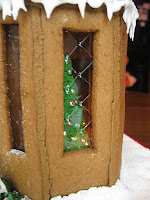This recipe comes from my husband's great-grandmother, and it is at least 100 years old. This one does not have actual meat in it, but suet (beef fat). For those who want to make this a vegetarian pie, just omit the suet altogether and add 1 teaspoon of instant tapioca or cornstarch to thicken it.
If possible, It is better to make this a couple of weeks ahead so the flavors can age. According to the directions, you are supposed to stir it every other day, adding a spoonful of Brandy each time you do. The recipe was originally meant to make A LOT of mincemeat, which would be sealed in jars and left to age for months, each jar enough to make one pie. But for this post, I have cut it down to a one pie recipe:
3 lbs apples (mostly very firm apples, though you can have a variety)
1 large box seedless raisins - dark, or a mix of dark and golden
3/4 cup chopped suet
1 tsp salt
1/2 Cup candied orange peel
1/2 Cup candied lemon peel
1 whole lemon, cut in half
3/4 Cup Sugar
1/4 cup molasses
1 teaspoon cinnamon
1/2 teaspoon allspice
1/2 teaspoon cloves
1/4 teaspoon nutmeg
pinch of mace
Peel and core the apples, and chop them into chunks. Put HALF of the apples, and HALF of the raisins into a large pot with the orange and lemon peel, the sugar, molasses, salt, and spices. Squeeze the lemon over the fruit, getting as much juice out as you can. Then put the lemon into the pot to simmer with the fruits (you will take it out later). Simmer (covered) on low for one hour, stirring often. Add the remaining apples and raisins and simmer for two or more hours, stirring often to make sure the bottom doesn't get scorched. Test it to make sure the candied fruits have softened. At this point you can add more sugar and spices to taste. Simmer longer if necessary to soften everything up, then take it off the fire and let it cool to room temp. Put in an airtight container and add a spoonful of Brandy to the top. Add a lid and let it sit for two weeks, stirring every other day and adding another spoonful of Brandy. (I have made this just a few days ahead and it is fine, but it will be better if you can give it the full two weeks).
Roll out a two crust pie dough (I like to use old time lard crust for this) and fill with the mincemeat. Bake at 400 degrees for about 40 minutes, checking after 20 minutes to see if the edges need to be covered with foil. Let it sit for 1-2 hours before serving.










.JPG)











